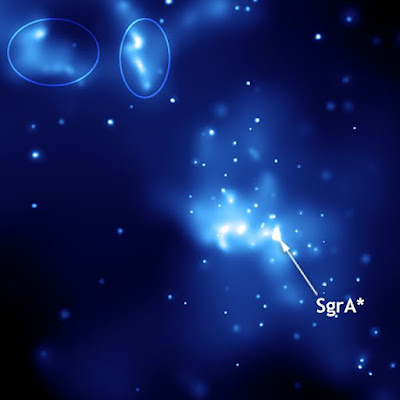- Kainulainen et al. 2016 (preprint) - Fragmentation of high line-mass filaments as revealed by ALMA: the integral shaped filament in Orion A (arXiv)
 |
| Image: This view of the Orion A star-formation cloud from ESA's Herschel space observatory shows the turbulent region of space that hugs the famous Orion Nebula. Credit: ESA/Herschel/Gould Belt Survey consortium |
They identify from the region 40 dense cores with masses on the order of a solar mass. The nearest neighbour separation distribution of the cores does not show a preferred fragmentation scale; the frequency of short separations increases down to our resolution limit. They show that the cores are significantly grouped at separations below ~17000 AU and strongly grouped below ~6000 AU. In addition, the two-point correlation function indicates periodic grouping of the cores into groups of ~30000 AU in size, separated by ~55000 AU.
These results suggest a two-mode fragmentation in which the maternal filament periodically fragments into groups of dense cores. The strong increase of separations below 6000 AU may be related to the regime of significant core-to-core interactions. They also find that the protostars in the northern ISF are grouped at separations below ~17000 AU
The stars with disks do not show significant grouping in the ALMA-covered region. This suggests that the grouping of dense cores is partially retained over the protostar lifetime, but not over the lifetime of stars with disks. This is in agreement with protostars being ejected from the maternal filament by the slingshot mechanism.
The separation distributions of the dense cores and protostars may also provide an evolutionary tracer of filament fragmentation.
_____________________________________________________________________
- Brown & Batygin 2016 (preprint) - Observational constraints on the orbit and location of Planet Nine in the outer solar system (arXiv)
Brown & Batygin (2016) use an extensive suite of numerical simulations to constrain the mass and orbit of Planet Nine, the recently proposed perturber in a distant eccentric orbit in the outer solar system. They compare their simulations to the observed population of aligned eccentric high semimajor axis Kuiper belt objects and determine which simulation parameters are statistically compatible with the observations.
They find that only a narrow range of orbital elements can reproduce the observations. In particular, the combination of semimajor axis, eccentricity, and mass of Planet Nine strongly dictates the semimajor axis range of the orbital confinement of the distant eccentric Kuiper belt objects. Allowed orbits, which confine Kuiper belt objects with semimajor axis beyond 230 AU, have perihelia roughly between 200 and 350 AU, semimajor axes between 300 and 900 AU, and masses of approximately 10 Earth masses.
Orbitally confined objects also generally have orbital planes similar to that of the planet, suggesting that the planet is inclined approximately 30 degrees to the ecliptic. They compare the allowed orbital positions and estimated brightness of Planet Nine to previous and ongoing surveys which would be sensitive to the planet's detection and use these surveys to rule out approximately two-thirds of the planet's orbit.
Planet Nine is likely near aphelion with an approximate brightness of 22<V<25. At opposition, its motion, mainly due to parallax, can easily be detected within 24 hours.
_____________________________________________________________________
- Giannios & Lorimer 2016 (preprint) - Flares from Galactic centre pulsars: a new class of X-ray transients? (arXiv)
 |
| Image: Sagittarius A*. This image was taken with NASA's Chandra X-Ray Observatory. Ellipses indicate light echoes. Credit: NASA/CXC/Caltech/M.Muno et al. |
Despite intensive searches, the only pulsar within 0.1 pc of Sgr A* is a radio-loud magnetar. Since magnetars are rare among the Galactic neutron star population, and a large number of massive stars are already known in this region, the Galactic centre (GC) should harbor a large number of neutron stars.
Population syntheses suggest several thousand neutron stars may be present in the GC. Many of these could be highly energetic millisecond pulsars which are also proposed to be responsible for the GC gamma-ray excess.
The 2 Gev excess gamma-ray emission from the GC detected by Fermi is consistent with an ensemble of order 1000 MSPs in this region (it should be noted, however, that the Fermi results can also be explained by a dark matter model).
In a recent paper (Giannios & Lorimer 2016) the authors propose that the presence of a neutron star within ~ 0.03 pc from Sgr A* can be revealed by the shock interactions with the disk around the central black hole.
They demonstrate that these interactions result in observable transient non-thermal X-ray and gamma-ray emission over timescales of months, provided that the spin down luminosity of the neutron star is L ~ 1035 erg/s.
Current limits on the population of normal and millisecond pulsars in the GC region suggest that a number of such pulsars are present with such luminosities.


Comments
Post a Comment